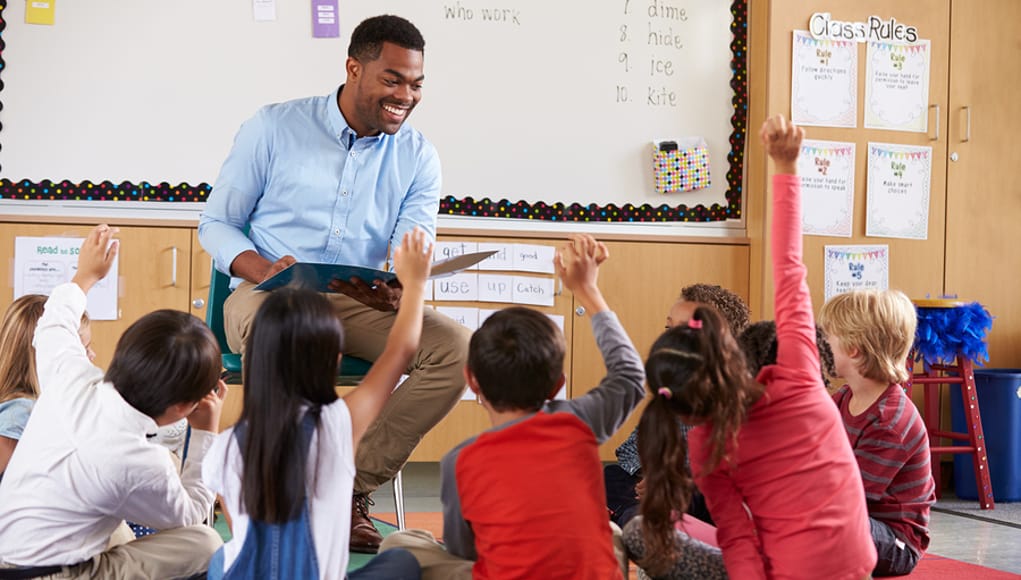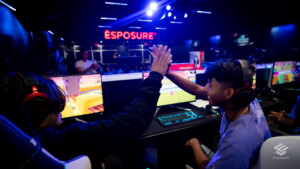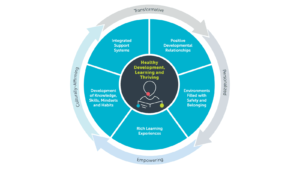What Students (and Schools) Can Do if We Stop Ranking Them

By Rhonda Broussard
This is the first of two interviews by Rhonda Broussard with Susan Patrick for the online series “One Good Question.” Susan Patrick is the President and Chief Executive Officer of the International Association for K-12 Online Learning (iNACOL).
In what ways do our investments in education reveal our beliefs about the next generation’s role in the world?
From a student-centered perspective, what are the investments being made in the learning environments? In a rapidly changing world, we need to examine the foundations of our education both for the purpose of education and its results. Are we preparing every student for the world they are entering, or are we investing in a factory model of education designed as an assembly line? The old model of education is under question and is being challenged by educators around the world with questions of appropriateness and whether it is fit for the purpose of preparing all students for success in today’s world.
 The investments made in today’s education system are often reinforcing the basic traditional structures to grade and sort students, with limited exposure to one class at a time, one subject at a time, one textbook at a time, with one teacher at a time—with inevitable outcomes of ranking students.
The investments made in today’s education system are often reinforcing the basic traditional structures to grade and sort students, with limited exposure to one class at a time, one subject at a time, one textbook at a time, with one teacher at a time—with inevitable outcomes of ranking students.
The premise of our society’s investments in an education system that is based on sorting kids remains, for the most part, unchallenged, rather than examining how funding could follow the student toward ensuring equity and support to ensure that every child reaches mastery of the same high standards and develops competencies for future success. School funding debates need to consider what designs are best suited to ensure each and every student has access to the best educational opportunities, and make a case for investments in a transformed system rather than tinkering with a system that sorts and ranks kids, which is designed for a world that no longer exists.
We have 13,515 school districts in the U.S. making investments in education approaches and environments. The traditional system is based on Carnegie units and seat time, providing varying levels of learning on an A-F grading system, and whether the students have gaps or not, the clock marches on. Are these investments that we’ve been making for the past 10-20 years designed to innovate and ensure student success? Are we making investments for each student to be able to have access to innovative models for equity? The investments in modernized education include the learning spaces, but more importantly, it’s the pedagogical experience for what’s happening in learning.
We have been historically funding a system based on minimal exposure to subjects with one way of approaching learning, and it is easy to manage through a bell schedule and calendar dictating how much learning might happen. The inverse would be to realize, in a given hour of time, that there might be variable amounts of learning. Thus, we need to design for supporting the maximum learning in each hour—not the minimal.
How do we design for how kids learn best? We need to know their readiness level, existing competencies, and how to meet them where they are. If we ask about how investments reveal what we believe about education, investing in a system that ranks and sorts kids means that we are okay with this approach.
 I would argue that we should invest in identifying what every student needs and ensuring the investment reflects an approach that maximizes every student’s potential and future success. Right now, we’re not investing in understanding where every student is when they enter school. What is their academic readiness level? What are their social and emotional, needs? How do we address the whole child and their learning experiences?
I would argue that we should invest in identifying what every student needs and ensuring the investment reflects an approach that maximizes every student’s potential and future success. Right now, we’re not investing in understanding where every student is when they enter school. What is their academic readiness level? What are their social and emotional, needs? How do we address the whole child and their learning experiences?
Today, we’re having an entire conversation in the United States about investing in summative testing as an autopsy at the end of the year instead of addressing the very needs of the students from day one. We talk about college and career readiness as part of an important goal in our K-12 education system. Our system is designed to rank and sort kids (GPA and class rank) to determine their college access. Is that not telling us that the system is built on an institutional fixed mindset? If we had an institutional growth mindset, we would hold the bar high for all students to learn to reach the same high outcomes. What does it take to get all students to the 4.0 GPA? This end goal would be a worthy investment for our future and our society’s future.
How do we innovate our system for all students to be successful?
During my Eisenhower Fellowship in New Zealand, when I walked into every school, I could see that they were focused on meeting students where they are. When I looked around the classroom, I could see the articulation of the curriculum frameworks on the importance of 21st-century skills, a broader definition of student success, visibility of the language of learning about rhetoric, context, thinking critically and solving complex problems. The wall posters actually had reminders to teachers regarding student outcome goals: creativity and entrepreneurial thinking, communicating and collaborating, making sense through the use of knowledge, research and synthesis, understanding the information, and opportunities to identify new ways of doing things.
Are we asking bigger questions on what we want our students to know and be able to do? The language of learning in modern classrooms with redesigned curriculum asks the “big questions” about the core concepts of learning, and it is all around you—whether in primary school or in secondary school—and targeted at the appropriate level. Students from a young age are learning from a metacognitive perspective: What are the ways I am thinking about this? Am I developing skills for a changing world? How is this relevant to how I might participate and contribute to a fair and just society? They ask themselves: am I analyzing? Am I learning how to function and self-manage? Am I learning new ways of working, new ways of thinking, and skills that I will need to make sense of the world?
In some New Zealand schools, they have multi-grade classrooms and the students have clearly identified learning objectives posted across multiple levels. The teachers are constantly working with every student to identify their learning goals, assess their performance on evidence of their mastery, and co-design the next steps as students move on to the next learning objective once they’ve demonstrated that mastery to the level of proficiency.

Each student can see what they need extra help in and can go to other students to get help. Every school and classroom was referring back to questions about how teachers can best meet students’ needs, how to personalize instruction, how they better identify students needs, which research-based practices are most effective, and how they can improve what’s working and not working. It was a culture of inquiry in a personalized learning environment.
David Hood, former head of NZQA, has described the traditional model of K-12 as the paradigm of one: one teacher, teaching one subject, to one class, at one time, for one hour. In New Zealand in 2007, they created a different curriculum that asked what each student needed to learn and do with a broader definition of student success. It gives a lot of flexibility to teachers and students in how they reach those goals, and holds all students to the same high standards. The five key competencies are:
- Thinking
- Using language, symbols and texts
- Managing self
- Relating to others
- Participating and contributing
Then Secretary for Education Sewell wrote, “The New Zealand Curriculum is a clear statement of what we deem important in education. It takes as its starting point a vision of our young people as lifelong learners who are confident and creative, connected and actively involved. It includes a clear set of principles on which to base curriculum decision-making. It sets out values that are to be encouraged, modeled and explored. It defines five key competencies that are critical to sustained learning and effective participation in society and that underline the emphasis on lifelong learning.”
We know through learning sciences that all students can learn and develop a growth mindset. We actually can create learning environments that will dramatically improve outcomes and do so in a way that empowers students’ own passions and interests. The education system in New Zealand includes many schools that have been designed around personalized learning and that are working intently on closing the achievement gap and raising the bar for all students.
The goal is that all students are not only meeting literacy and numeracy skills, but ultimately, when they graduate, they’ve built a whole set of knowledge, skills, competencies and dispositions that will lead to them being contributive in society and help contribute to the free and open society. New Zealanders’ cultural values are deeply reflected in their education work. Maybe that’s easier to do when each school is autonomous and school can set their values clearly.
New Zealand schools have more local control than the States, don’t they?
Absolutely! Some education systems are top down, others are bottom up in terms of their governance and control. In New Zealand, each school is autonomous and self-managed with their own principal and each has its own elected board of trustees from the community. They set values and goals, and set the accountability framework for results and metrics.
How community values tie into local control is interesting. New Zealand is really a case study in both the empowerment of local schools and local families setting their own accountability goals. The opening presentation of the first school that I visited was about their annual goal to reach 1.5 years of growth for each student. That goal was set by the community. Everyone was on the same page, clear and transparent about that target and what they needed to do. All families have choices for the school they attend, and they choose to go the school.

It’s a nice balance in New Zealand, where the top-down is having the Ministry of Education work across all schools to design a curriculum framework that will ensure a broad definition of student success and ensure the bar is the same high bar for all students. The top-down approach is simply examining the research on a world-class education to set that bar high to make sure the curriculum is right, but the empowerment is bottom-up, creating capacity for educators and practitioners to design learning activities around the research on how students learn best.
I also observed how local control impacts their governance. In the U.S., our unit of local elections is with the local district’s school board. Anyone can run and anyone with political aspirations can be elected to the local school board (if they win the vote) as part of further political aspirations. In New Zealand, you’re only eligible to run for Board of Trustees of a school if you’re nominated by a teacher or parent in that school community. It is an interesting approach to building community engagement and capacity.
In the discourse about preparing youth for jobs that don’t yet exist, educators fall into two camps: skills-focused (STEM, design thinking, makers, etc.) and people-focused (critical thinking, global sensitivity and social-emotional learning). To what extent are we creating a false dichotomy?
I think it’s a false dichotomy. Learning is an incredibly humanistic pursuit. We’re talking about helping each and every child work to their full potential, which is tied to relationships, understanding student interest, and student goals and how to achieve them.
In the world that we live in today, you can access a lot of content—it’s all available to you. But what’s more important is having a baseline knowledge on how content fits together and how you can approach critical thinking, creativity, problem-solving and questioning the ideas and perspectives presented to you. That’s really important in terms of being relational and contextual in the idea of people focused—how do we challenge or explore ideas effectively? Cultural responsiveness, global sensitivity and social-emotional learning (SEL) are becoming more important than ever. Having those deep people-focused skills doesn’t mean that you can’t also be approaching STEM or creative design or being “makers” together.
Back to New Zealand, I visited schools with more interdisciplinary approaches to learning. Students are able to identify big conceptual projects, design learning experiences that respond to community or students’ needs, and then map which standards and subjects they’ll be addressing in these projects.
For example, in one school, I walked over to the closest student, a 15-year-old boy, and asked him about his project. He said he was studying Artificial Intelligence (AI), and he explained his full plan to me. First, he would first conduct a literature review on how AI has evolved over the past 30 years. Then, he wanted to explore what trends were likely to occur in the next five years in AI, and finally he wanted to finish the project with an analysis of the societal and ethical implications of AI in the future. He explained how he would be able to be evaluated across many of the key competencies and develop mastery of standards—he shared that he is mapping his project to the attainment of science standards, some math standards, some English/text/communication standards, and social studies standards for the ethical implications.
The variety of ways he was able to build an understanding of the world, but at the same time earn attainment of competencies and credits for his qualifications toward a degree, was impressive. That’s a great example of how an education system can be both skills-focused and people-focused, with interdisciplinary approaches using multiple perspectives contributing to deeper learning that is highly personalized for each student.

Even in their elementary schools, I witnessed New Zealand’s teachers asking students to take on big questions and build the capacity for learning in their own classrooms. This means really giving students agency and empowerment with the language around learning through analysis, perspective and ethics. It was really amazing how young students were very focused on knowledge and the range of skills that they were developing.
As David Hood noted, “Literacy and numeracy do include the ability to use language, symbols and texts; but these are only tools—it is the ability to use these interactively, in a connected way in context, that the OECD identifies as most important, as it does in being able to use both knowledge and information, and technology, in interactive ways.” Teachers were trying to not only give students the language, tools, and strategies to address academic issues, but the strategies that would help them solve more complex problems and ultimately be successful in college, career, societies and their communities.
Susan’s One Good Question: I’m a positive person with a positive outlook, but the future of our country has never been more at stake. We have some hard decisions to make right now. We have successfully under-educated our population in such a significant way that we really need to address this gap.
We’re investing a lot of dollars in education, but is it based on the research for how students learn best? Are we investing toward a more open and just democratic society in a global context where issues will become more messy and more challenging than ever? Will we be investing in the capabilities of thinking critically and creatively and problem-solving with the deep cultural responsiveness we will need to navigate an increasingly changing world?
This blog was originally posted on rhondabroussard.com.
For more, see:
- Overhauling How We Teach Our Kids in a World of Accelerating Change
- Pacing in Competency-Based Learning
- 6 Ways States Can Redefine Student Success and Transform Education Under ESSA
Rhonda Broussard produces One Good Question, where she explores international education and access for all students through multiple lenses, but all with the same question. Follow her on Twitter: @BroussardRhonda.
Stay in-the-know with all things EdTech and innovations in learning by signing up to receive the weekly Smart Update. This post includes mentions of a Getting Smart partner. For a full list of partners, affiliate organizations and all other disclosures, please see our Partner page.







0 Comments
Leave a Comment
Your email address will not be published. All fields are required.